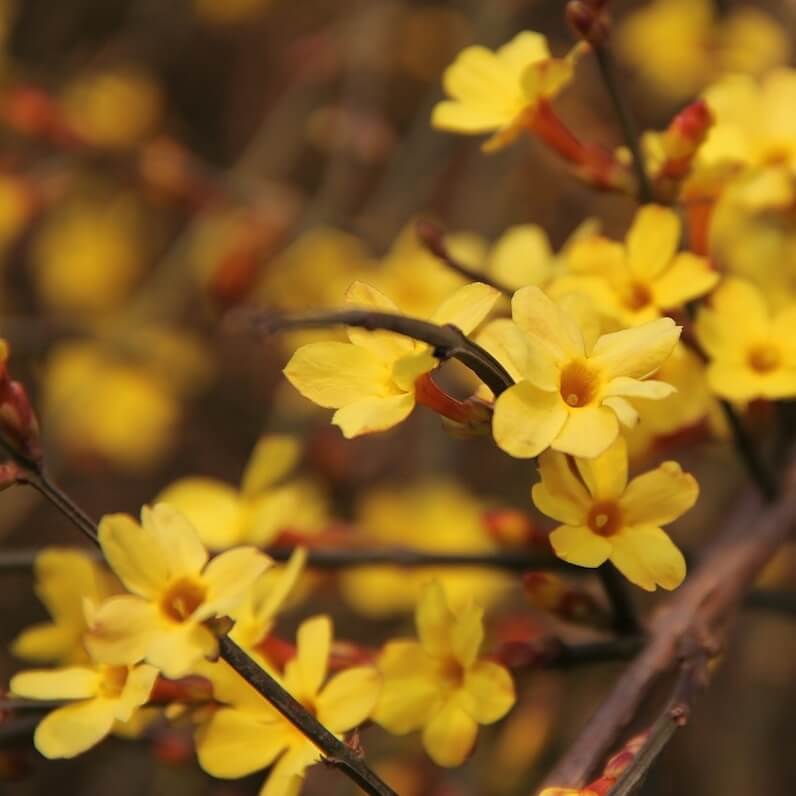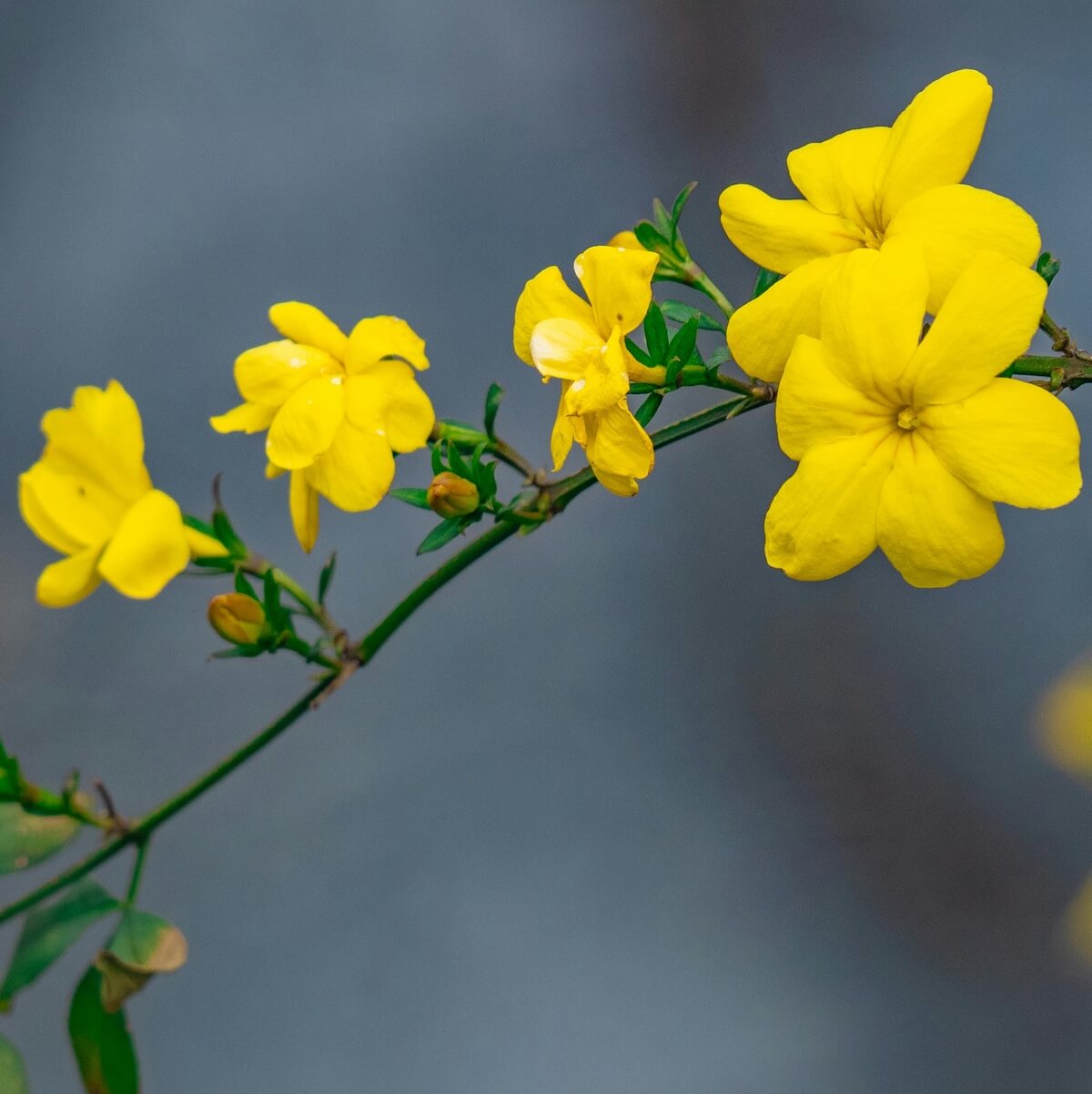
Position
- Full sun to partial shade
- South or west-facing walls ideal
- Sheltered position preferred
- Can tolerate exposed sites if well-supported
Hardiness
- Tolerates temperatures down to -15°C (5°F)
- Fully hardy throughout UK
Soil
- Well-drained fertile soil
- Chalk, clay, sand, or loam
- Must not be waterlogged
- Adaptable to acid, neutral, or alkaline soils
- Performs best in neutral to slightly alkaline
- Grab a soil test kit and ensure the perfect conditions for growth
Height
- Height: 2.5-3 metres
- Spread: 2.5-3 metres
Seasons of Interest
- Flowering: December to March
- Bright yellow flowers on bare stems
- Green foliage present spring to autumn
- No autumn colour
- No variegation
Additional Notes
- Excellent winter flowering climber
- Can be used as ground cover on banks
- Not fragrant, unlike other jasmines
- Benefits from hard pruning after flowering
- Stems root where they touch soil
- Train young plants horizontally to promote flowering
- Good for covering walls, fences, and banks
- Very low maintenance once established
- Can appear untidy if not properly trained
- Flowers best on previous year’s growth
Jasminum nudiflorum: How to Grow the Bright Winter Jasmine That Blooms When Others Don’t
Jasminum nudiflorum, commonly known as winter jasmine, is a welcome burst of colour in the depths of winter when most of the garden lies dormant. Its cheerful yellow flowers and low-maintenance nature make it the perfect plant for covering walls, fences, or low garden structures during the coldest months. This comprehensive guide covers everything you need to know to cultivate and enjoy this bright, reliable winter-flowering shrub.
What is Jasminum nudiflorum?
Winter jasmine is a deciduous, winter-flowering shrub or climber native to western China and Tibet. Unlike its summer-flowering relatives, this species produces bright, butter-yellow star-shaped flowers on bare green stems from November to March. The blooms are unscented but highly visible, creating a stunning contrast against winter’s bare branches and grey skies.
This resilient plant has been awarded the Royal Horticultural Society’s Award of Garden Merit, a testament to its reliability, ornamental value, and ease of cultivation. Even when not in flower, the bright green stems add texture and colour to the winter garden.
How to Plant Jasminum nudiflorum
Select a site in full sun or light dappled shade to give your winter jasmine the best start. A south or west-facing aspect is ideal, particularly if you want to encourage prolific flowering. While this plant tolerates a range of soil types, it thrives in fertile, free-draining soil enriched with organic matter.
Before planting, prepare the soil thoroughly by incorporating well-rotted manure or compost. Although Jasminum nudiflorum is naturally arching and can scramble freely, it will benefit from the support of wires, a trellis, or an obelisk if you want to train it vertically. Plant at the base of the support and angle the young stems towards the structure to help them establish.
When Does Winter Jasmine Flower?
One of the standout qualities of Jasminum nudiflorum is its ability to flower during the darkest time of year. While most garden plants are dormant, this jasmine bursts into bloom from late autumn to early spring — typically November through March — depending on weather conditions and location.
The small, six-petalled yellow flowers appear singly along the bare stems, often opening before any leaves emerge. This leafless flowering habit gives the plant an elegant, architectural presence and ensures that the vivid blooms take centre stage.

How to Train Jasminum nudiflorum
Although not an actual climber, winter jasmine has long, flexible stems that can be trained and tied into supports, making it ideal for walls, fences, or trellises. Use soft ties to secure new growth as they extend gently, spacing them out to encourage an even, fan-like display.
Alternatively, you can allow it to spill naturally over a low wall or raised bed, forming an attractive cascading mound. When used this way, Jasminum nudiflorum functions more like a sprawling shrub, providing useful groundcover and softening hard edges in the garden.
How to Prune Winter Jasmine
Pruning is key to keeping winter jasmine healthy, vigorous, and flower-filled. Once flowering has finished—usually by late March or early April—prune back the stems to maintain shape and encourage new growth for next year’s display.
Cut back one-third of the oldest stems to the base, and thin out any congested or crossing growth. This rejuvenates the plant and encourages a flush of new shoots that will carry next season’s flowers. Regular pruning also prevents the shrub from becoming too woody or leggy.
Plant Combinations: What Grows Well with Jasminum nudiflorum?
Winter jasmine works beautifully alongside other seasonal stars. Try pairing it with Galanthus nivalis (snowdrops) for a striking yellow-and-white display that brightens up early borders. Erica carnea (winter-flowering heather) also complements its bloom time and adds texture and colour to the surrounding planting.
For a striking contrast, grow Jasminum nudiflorum near Betula jacquemontii (Himalayan birch), whose gleaming white bark enhances the vivid yellow flowers. It also works well with evergreens, such as Buxus or Lonicera nitida, which provide year-round structure while allowing winter jasmine to shine in its season.
Is Jasminum nudiflorum Easy to Grow?
Yes — one of the main appeals of winter jasmine is its reliability and low-maintenance nature. Once established, it’s highly tolerant of many conditions and rarely troubled by pests or diseases. It copes well with urban pollution and exposed sites, making it suitable for city and coastal gardens.
As with most climbers or wall shrubs, the main maintenance tasks involve occasional watering during prolonged dry spells, pruning after flowering, and tying in new shoots as required.
Does It Need Special Winter Care?
Despite its winter blooming habit, Jasminum nudiflorum is a hardy plant that requires little extra protection from frost or cold. It performs best in winter and is one of the few plants that actively flower through the year’s coldest part.
However, in very exposed locations or during severe frosts, a layer of mulch around the base in autumn can help protect roots and maintain soil moisture. The bright green stems retain their colour throughout the colder months, adding a fresh note of green to the winter landscape.
Can I Use Winter Jasmine for Cut Flowers?
Absolutely. The slender, arching stems topped with sunny yellow flowers make delightful indoor arrangements, especially during the bleak winter. Cut stems when the buds are just beginning to open and place them in fresh water for a longer vase life.
They pair nicely with branches of dogwood, pussy willow, or early-flowering forsythia for a natural, seasonal bouquet. A small vase of winter jasmine on a windowsill or table can lift the mood and bring the outside in when you need it most.
From Darren’s Patch
Winter jasmine has become one of my go-to plants for adding life and colour when the garden is quiet. I grow it along a south-facing wall near my back door, where I can see those vivid yellow blooms every time I pop outside. Something is uplifting about seeing flowers in the middle of January, especially when everything else is bare. What I particularly like is how easy it is to manage. A light prune after flowering and a few ties here and there, and it just gets on with the job. It also scrambles beautifully over low walls, softening hard lines and adding a bit of cheer when it’s most needed. If you’re after a plant that delivers a reliable winter show with very little fuss, Jasminum nudiflorum is a real winner.
![]()
Key Points to Remember:
- Flowers from November to March
- Hardy and easy to grow
- Needs regular pruning after flowering
- Works well as a climber or a wall shrub
- Tolerates full sun or semi-shade
- Perfect for winter interest
- Pairs well with other winter-flowering plants
- Minimal maintenance required
- Good for cut flowers
- Reaches 3-4 metres in height
Whether trained along a wall, tumbling over a low fence, or paired with other winter stars, Jasminum nudiflorum offers a much-needed splash of colour when the garden feels quiet. Hardy, undemanding, and full of cheerful charm, it’s an ideal choice for brightening winter days and lifting the landscape year after year. With just a little care, this reliable bloomer will reward you with weeks of golden flowers when you need them most.
Check out the RHS article here.
Explore our full collection of planting guides for expert advice on climbers and wall shrubs.
Want to learn about other climbers? Read about Jasminum officinale here.
Frequently Asked Questions
Q: What is Jasminum nudiflorum, and how does it fit into my winter garden?
A: Jasminum nudiflorum, also known as winter jasmine, is a lovely deciduous shrub that blooms even in winter, bringing a splash of colour to your garden. It’s perfect for brightening up those bare patches during the colder months!
Q: Is Winter Jasmine a shrub or a climber?
A: Winter jasmine can be both! It’s mainly a shrubby plant, but if you let it scramble freely, it can also act as a climber. It’s versatile, so you can train it to grow however you want!
Q: When does Jasminum nudiflorum typically bloom?
A: This plant is a winter superstar! It usually blossoms in late winter and early spring, even when most other plants remain dormant. Those bright yellow flowers are a cheerful sight during the colder months!
Q: What kind of care does a Winter Jasmine need?
A: Winter jasmine is pretty low-maintenance but loves well-draining soil and a sunny spot. It doesn’t mind being left to its own devices, and older plants can handle a bit of neglect. Just make sure to prune it lightly after flowering to keep it healthy!
Q: How can I use Winter Jasmine in my garden design?
A: You can use winter jasmine to fill in bare patches in your yard, or let it climb up trellises and fences for a lovely display. It looks just as attractive mingling with shrubs like Viburnum x bodnantense or spring bulbs like crocus.
Q: Are the flowers of Jasminum nudiflorum fragrant?
A: While the flowers are beautiful and eye-catching, they aren’t fragrant. If you’re looking for a fragrant shrub, you might want to consider other options like daphne or viburnum.
Q: Is Winter Jasmine suitable for all gardens?
A: Yes! Winter jasmine is a great choice for virtually any garden in the northern hemisphere. It’s adaptable and can thrive in various conditions, making it a favourite among gardeners looking to add some winter colour.
Q: How do I propagate Winter Jasmine?
A: Propagating winter jasmine is super easy! You can take cuttings from the stems in winter and early spring. Just make sure to use healthy, green stems to increase your chances of success.
Q: What should I do with my Winter Jasmine in autumn?
A: In autumn, you can enjoy the lovely leaves as they change colour before dropping. There’s really not much to do; just sit back and admire the beauty of this climber as it prepares for its winter show!
